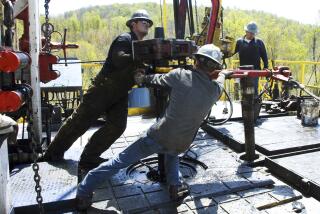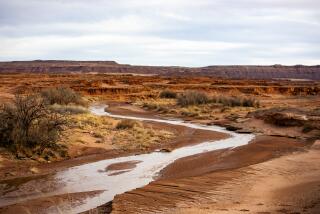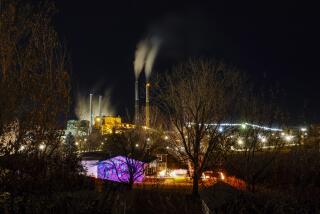Unlikely Allies Resist Drilling Plan
RIFLE, Colo. — The Colorado River helped sculpt the deep brown mesas and pine-covered hills of western Colorado, home to Cathedral Bluffs and the soaring Roan Cliffs, their slopes falling swiftly to the valley floor.
More and more, this striking landscape is being reshaped by iron towers and earth-colored boxes 6 feet tall. These are drilling rigs and wellheads, signs of an underground natural gas reserve that industry experts say may be the biggest in the country -- 21 trillion cubic feet of recoverable fuel, enough to heat 315 million homes for a year and a treasure worth billions of dollars.
Much of this gold mine is under Colorado’s Roan Plateau, 127,000 acres in the heart of the Rockies -- a region described last month by the head of the Federal Energy Regulatory Commission as “ground zero” in the Bush administration’s plan to step up domestic energy development.
That plan has already led to social and economic changes across the high plains of Montana and Wyoming, and the sagebrush-dotted deserts of New Mexico and Utah. Gas companies are hauling in drilling rigs, and crews are filling up the motels and restaurants of small towns desperate for the revenue.
The boom, however, is running into criticism from an unlikely alliance of hunters, ranchers, environmentalists and others who say energy companies are running amok, building roads and drilling wells without permission. Fights are breaking out over mineral rights involving ranchers who until now had been more familiar with cattle prices and winter wheat. Some have gone to court to keep the energy companies off their land.
Some of those who live in the West’s far-flung reaches believe that public land should be available for energy development. But they are calling for the government to put on the brakes, worried that the new boom is threatening both the environment and the outdoors-based economy that has replaced the oil-and-gas days of the 1970s and ‘80s.
“We’ve seen this industry go boom and bust a couple times,” said Peggy Utesch, a media consultant who lives in Silt, east of Rifle. “For people like us that live in this valley and probably will for the rest of our lives, that is a big concern.”
The economy in much of western Colorado went into a tailspin after its last big bust on May 2, 1982, or “Black Sunday,” the day that Exxon closed oil-shale operations in Parachute and 2,200 jobs vanished. Since then, many rural communities have cashed in on mountain vistas and a slow pace to attract retirees, entrepreneurs and tourists.
Now comes a new energy rush, spurred by skyrocketing gas prices and an administration determined to rely more on domestic energy resources, particularly cleaner-burning natural gas. The government estimates that a five-state region of the Rockies -- Colorado, Montana, New Mexico, Utah and Wyoming -- contains 41% of the nation’s gas reserves.
Greg Schnacke, administrator of the Colorado Oil & Gas Assn. trade group, said the Rockies will play a key role in energy development as long as the Arctic National Wildlife Refuge in Alaska and offshore drilling are off-limits.
The region is already seeing the effects: Colorado, with 25,000 active wells -- 83% are gas -- expects to issue about 2,300 permits this year, double the amount just four years ago. In Garfield County, which includes much of the Roan Plateau, some 550 wells will soon be added to the 1,800 already in place -- a 31% increase.
Wyoming, with 40,300 wells, issued a record 10,470 permits in 2001 and is on pace to issue 7,400 this year.
“They’d probably drill in the Sistine Chapel if they thought there was gas there,” said Liz Howell of the Wyoming Wilderness Assn. “This is our cultural heritage as well as our natural heritage, the wild places.”
Peter Morton, a resource economist with the Wilderness Society in Denver, said the nation has a lot of gas in reserve and accused the government of pushing too far.
“What’s the hurry, other than there’s an administration favorable to development?” he asked.
Residents, newcomers and veterans both, have teamed up to block wells on their land and in such natural treasures as the Rocky Mountain Front in Montana, the Red Desert in Wyoming, the Book Cliffs in Utah and the Roan Plateau. Some of these same ranchers, hunters and environmental groups used to fight each other over such issues as livestock grazing on public lands and protection of endangered species.
Things have changed: It was environmental groups that Tweeti and Linn Blancett turned to when several energy companies began drilling gas on their ranch in northwestern New Mexico.
“We found we have a lot of common ground and, when we don’t agree, we leave it alone,” said Tweeti Blancett, who now talks to ranchers on behalf of environmental groups.
Energy companies have poured into the Rockies the last few years, flooding state and federal agencies with drilling applications and complaining that it takes too long to get them approved. New and expanded pipelines have cut transportation costs and opened new markets. Improving technology is making it easier to extract gas from the often-challenging geology of the West.
Industry officials complain that lawsuits by environmentalists bog down leasing and drilling on public land, driving up costs for producers and millions of consumers.
“An environmental impact statement takes years to get done and, after they’re recorded and the decision is made, they’re immediately challenged in court,” said Joe Jaggers, vice president of exploration and production in the Denver office of Williams, a Tulsa, Okla.-based energy company.
His company and others are interested not only in the Uinta-Piceance Basin, a geological formation that spreads into Utah and includes the Roan Plateau, but the San Juan Basin straddling New Mexico and Colorado.
That region, the nation’s No. 1 producer of gas from coal beds, already has 20,000 wells. Another 10,000 are planned over the next 10 years.
“There are huge reservoirs off the coasts and Gulf of Mexico that are off-limits, but these reservoirs are available to be developed,” Jaggers said.
With some caveats. Millions of acres of Western public land are used for ranching and recreation. Some is set aside for national parks, monuments and wilderness.
The Bush-backed energy bill, expected to be revived in Congress next year, calls for speedier review and approval of energy development on federal land -- roughly 40% of the Rockies’ total acreage.
Chuck Blixrud, who has run guest and working ranches near Choteau, Mont., for 44 years, said he fears that he may be out of business if regulators expand gas drilling along the eastern slopes of the Rocky Mountain Front.
The region, home to one of the country’s largest grizzly bear populations, was declared off-limits to energy development under President Clinton.
“People pretty much welcomed energy development in the past because it did help the economy,” Blixrud said.
“People nowadays are taking a serious look at the pros and cons, and just don’t want to see things happen to harm the landscape. This kind of country is shrinking,” he said.
La Plata County in southern Colorado has successfully fought state regulators and companies in court for a say in oil and gas production, including requiring wells to be at least 400 feet from a home.
“You have people moving in here who were not reliant on energy jobs. They bought their 5, 10, 20 acres of southwestern Colorado and, all of a sudden, boom! They’ve got a gas well 150 feet from their back porch,” county Commissioner Josh Joswick said.
Not far away, the Blancetts have locked their gates to limit access to energy companies that hold the rights to minerals under parts of their 32,000-acre ranch near Aztec, N.M. The companies have challenged the move in court.
Tweeti Blancett, a staunch Republican, said she rejects the Bush administration’s argument that development must speed up to make the country more energy independent.
“We’re going to have to slow these boys down or we’re not going to have any West left,” she said.
More to Read
Sign up for Essential California
The most important California stories and recommendations in your inbox every morning.
You may occasionally receive promotional content from the Los Angeles Times.









